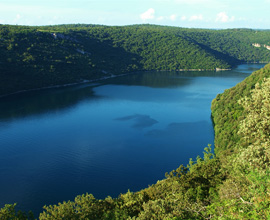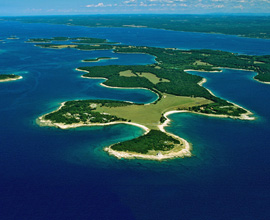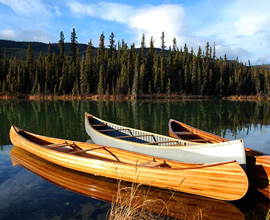
Our exact location in Premantura
The vicinity of the sea and the many tourist facilities offered, makes the Kamenjak area suitable for all kinds of summer and water sport activities with an emphasis on scuba diving, windsurfing, sea skiing, fishing and driving all kinds of own or rented water-vehicles for which several marinas and facilities are available in or near Premantura.
There are a few tourist resorts in the vicinity of Premantura: Medulin, Banjole, Pješcana Uvala and Pomer with rich gastronomical, cultural and sport facilities, during the summer but also during the rest of the year.

Microlocation - Premantura and Pula
The apart hotel "Miriam" is located in Premantura, Istria's most southern village, near Pula (8 km). It can be reached by taking the southern exit of the Trieste - Pula state road, which leads to Premantura.
There are approximately 800 inhabitants in the village itself. There are also several shops, restaurants, bars, a night club and various tourist facilities. The apart hotel is located on the edge of the rural area of Premantura, near the sea (450 m), just opposite to the entrance to the "Kamenjak" nature park and its many kilometers of beaches.
Kamenjak is a 9.5 km long 1.5 km wide peninsula which spreads into the sea like a big hand. It is surrounded with 30 km of coast including numerous caves, small bays and miniature beaches, and its primeval beauty is enriched by the surrounding islands rising from the crystal clear blue-green sea.There are 530 plant species on cape Kamenjak, 20 of which are orchids including several endemic species, some of which on the verge of extinction, and therefore specially protected.
Cape Kamenjak is a legally protected natural landscape and its southern part (400 ha) is soon to be named a botanical reservation. Automobiles must pass the ramp at the entrance and the fee is 15 kn per day. There are no admission fees for passengers.

Macrolocation - Istria
The county of Istria consists of the largest part of the istrian peninsula with a total of 2820 m2. A small part of Istria belongs to the Republic of Slovenia. 204 346 inhabitants live in the croatian part of Istria (250 000 in whole county of Istria). The population is mainly concentrated in 7 towns (124 899 inhabitants), of which 30,5 % live in the city of Pula. All larger towns in Istria are located on the coast and are all well known croatian tourist resorts: Rovinj, Porec, Pula, Medulin, Umag, Rabac.
The coast is 190 km long, rocky and mostly covered with mediterranean forests. More than 3000 years of rich european history are saved in archeological remains. The first known inhabitants accepted early Roman culture, and later contacts with the Republic of Venice and the Austro-Hungarian monarchy have kept Istria within the European historical development. Archeological remains show Istria to be one of the earliest-populated parts of Europe, but also point out the need for further exploration.
Istria is geographically and geometrically situated in the center of Europe, where the sea cuts deepest in the mainland. A circle of 250 km encircling Istria would reach 14 states. A 500 km circle would reach 30 states with more than 350 000 000 people. Istria is equally distant from the North Pole and the Equator, situated on the 45th northern parallel. The climate is mediterranean, mild, with some elements of the continental in the inner parts of the peninsula. There are no significant temperature amplitudes. The landscape varies from the mountain massives of Uèka and Æiæarija on the north-east to the plains near the sea on the west of the peninsula.
A part of the land in Premantura's vicinity is cultivated, mostly with vegetables and grapes (from which several types of wine are produced including Malvazija and Teran), and the surrounding forests are rich with mushrooms during the entire year. Wild asparagus is one of the most famous Istrian dishes and it attracts many tourists (mostly Italian) during the picking season.